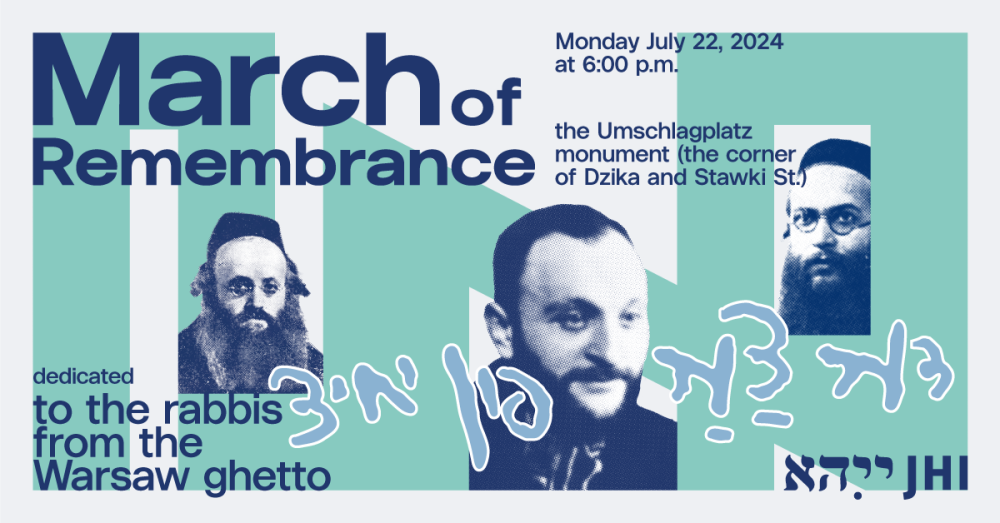Menu
- News
- Events
- Oneg Shabbat
- Collections
- Research
- Exhibitions
- Education
- Publishing Department
- Genealogy
- About the Institute
- Bookstore


The march will start on July 22 at 18:00 from the Umschlagplatz monument in Warsaw (10 Stawki St., corner of Dzika St.) and will follow a symbolic route through Stawki, Andersa, Anielewicza, Zamenhof streets, and will end at 5 Dzielna St, where an art installation will be unveiled, we will also hear a cantor's song and fragments of the rabbis' writings.
_____
On 22 July 1942, the Germans launched the so-called ‘Grossaktion’ – a mass deportation of Warsaw Jews to the Treblinka death camp. By 21 September, nearly 300,000 Jews perished in the Umschlagplatz – the holding area in Stawki Street where transports were loaded – in overcrowded trains headed to the camp, and in Treblinka itself.
This year’s March of Remembrance is dedicated to the memory of the rabbi from the Warsaw ghetto. After the outbreak of World War II, religious people – at the time the majority of the Jewish community – were particularly harshly targeted by the German repressions. They had their beards cut off and traditional garb ridiculed, they were beaten and banned from holding group prayers or services. Still, religion unified many ghetto residents, helping them keep hope alive in extremely challenging times.
The rabbis staying in the ghetto differed in their interpretations of their role as leaders of religious life in the Jewish quarter. Some devoted their time to studying scriptures and teaching, others participated in aid initiatives, even those organised by lay institutions, and there were also several rabbis who worked with the Oneg Shabbat group. They offered guidance when asked for assistance, showed people compassion, and helped them keep their spirits high.
We have decided to show the predicament of religious Jews in the Warsaw ghetto, with particular focus on the role and importance of their spiritual leaders, through the lens of the biographies of five rabbis: Shimon Huberband, Kalonymus Kalman Shapira, Shimshon Sztokhamer, Menachem Ziemba, and Josef Leib Gelernter. Each chose a different path in fulfilling their mission, but all took immense efforts to help their communities – at the same time grappling with the meaning of suffering and the presence of God in the cruel world around them.
The March of Remembrance will be accompanied by a sculpture by Norbert Delman created in cooperation with HOS Gallery, which will remain in the city space until September 21, commemorating the entire period of the great liquidation action.
_____
The March of Remembrance will begin on July 22, 2024, at 6:00 p.m.
Route: Umschlagplatz – Stawki – Andersa – Anielewicza – Zamenhofa – 5 Dzielna St.
At the beginning of the event, volunteers will distribute symbolic Ribbons of Remembrance with names of murdered Jewish deportees and refugees.
![Mapka(3).jpg [451.65 KB]](https://www.jhi.pl/storage/image/core_files/2024/7/19/dd948f1ae2c36e40d72093268a5decb8/jpg/jhi/preview/Mapka(3).jpg)
![_belka_pion_EN.png [91.55 KB]](https://www.jhi.pl/storage/image/core_files/2024/7/12/da6eeafdac72253e6f39262d4a875e1c/png/jhi/preview/_belka_pion_EN.png)